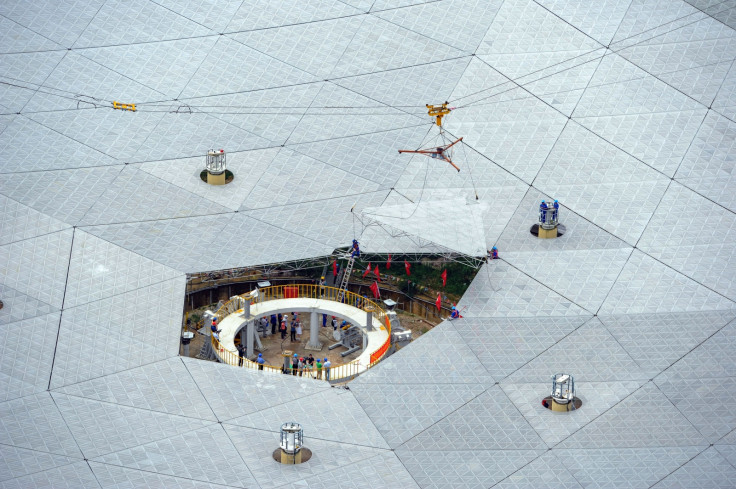China: World's largest radio telescope Fast set to begin operations in September
Reflector of the telescope in Pingtang county is the size of 30 football fields.

China's new 500m-wide Aperture Spherical Telescope (Fast), the world's largest radio telescope, is set to begin operations from September after installation was completed on Sunday (3 July). The giant telescope will have 5 to 10 times more potential to detect extraterrestrial life, according to Peng Bo, director of the NAO Radio Astronomy Technology Laboratory.
Zheng Xiaonian, deputy head of the National Astronomical Observation (NAO) that built the telescope, said the device will be the global leader for the next 10 to 20 years. He added that scientists will soon begin debugging and trial observation of the telescope.
With the fitting of the last panel at the centre of the 4,450-panel radio telescope on Sunday morning, the installation work was completed. Work began on the 1.2bn Chinese yuan ($180m) Fast project in 2011. The telescope reflector is the size of 30 football fields, China's official news agency Xinhua reported.
Peng Bo told the news agency that the telescope is bigger than Puerto Rico's Arecibo Observatory, whish has a diameter of 300m. He said the telescope will be 10 times more sensitive than the steerable 100-metre telescope near Bonn, Germany.
The final touches to the installation work at Karst valley in Pingtang county in the south-western province of Guizhou was witnessed by about 300 people, including builders, experts, science fiction enthusiasts and reporters.
Peng Bo said during the initial two to three years of its operation, the telescope will be used for early-stage research, while it will continue to undergo further adjustments. The telescope will then be left to scientists worldwide, who will be able to carry out remote control and observation from cities such as Beijing, more than 2,000 km away from the telescope site. Peng Bo said: "Fast's potential to discover an alien civilisation will be 5 to 10 times that of current equipment, as it can see farther and darker planets."
Wang Qiming, chief technologist of the Fast project, said it is mostly indigenously-built; five of the seven Fast receivers were built domestically, while the other two were co-produced by Chinese, Australian and American organisations.
"As the world's largest single aperture telescope located at an extremely radio-quiet site, its scientific impact on astronomy will be extraordinary, and it will certainly revolutionise other areas of the natural sciences," Nan Rendong, chief scientist with the Fast project, said.
"The telescope is of great significance for humans to explore the universe and extraterrestrial civilisations," Liu Cixin, an award-winning science fiction writer, told the news agency. "I hope scientists can make epoch-making discoveries," Liu added.
© Copyright IBTimes 2025. All rights reserved.





















